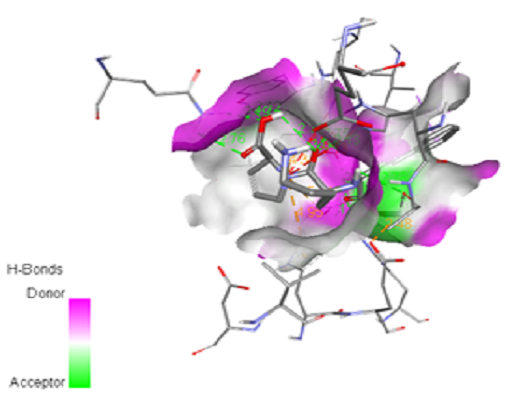Study of Anthocyanin Molecule Blocking as Anti-Hypertensive through the Pathway of the Renin-Angiotensin-Aldosterone System (RAAS)
Abstract
Anthocyanins are flavonoid-derived compounds that can reduce blood pressure. This study aims to determine the affinity value of the compound to bind to Angiotensin Converting Enzyme (ACE) and bind to Angiotensin II type 1 Receptor (AT1R) and to determine the distance and shape of the bond that occurs. The results of anthocyanin-derived compounds Delphinidin, Petunidin, Malvidin, Cyanidin, Peonidin, and Pelargonidin have anti-hypertensive potential through the Renin Angiotensin Aldosterone (RAAS) pathway based on molecular docking calculations. The affinity value of each, against Angiotensin Converting Enzyme (ACE) -7.7; -7.8; -7.7; -7.7; -7.8, and -7.7, the best affinity value in anthocyanin-derived compounds is shown in the Malvidin test compound which has three types of hydrogen bonds at a distance of ± 2 Å (ASP377, TYR520, ASP415) and has 1 type of bond that is the same as the lisinopril control (TYR520). While the affinity value to Angiotensin Receptor (AT1R) is -7.7; -7.7; -7.8; -7.7; -7.8, and -7.6, respectively, the best affinity value is shown in the Malvidin test ligand compound of -7.8 kcal/mol which has four types of hydrogen bonds ± 2 Å distance (TYR92, SER105, ARG167, TRP84) and has one kind of bond in common with lisinopril control (TYR520).
Downloads

Copyright (c) 2023 Dwi Budiarto, Bambang Wijianto, Hariyanto IH

This work is licensed under a Creative Commons Attribution-NonCommercial-NoDerivatives 4.0 International License.
Authors who publish with this journal agree to the following terms:
- Copyright on any article is retained by the author(s).
- The author grants the journal, the right of first publication with the work simultaneously licensed under a Creative Commons Attribution License that allows others to share the work with an acknowledgment of the work’s authorship and initial publication in this journal.
- Authors are able to enter into separate, additional contractual arrangements for the non-exclusive distribution of the journal’s published version of the work (e.g., post it to an institutional repository or publish it in a book), with an acknowledgment of its initial publication in this journal.
- Authors are permitted and encouraged to post their work online (e.g., in institutional repositories or on their website) prior to and during the submission process, as it can lead to productive exchanges, as well as earlier and greater citation of published work.
- The article and any associated published material is distributed under the Creative Commons Attribution-NonCommercial-NoDerivatives 4.0 International License.





_copy1.png)










